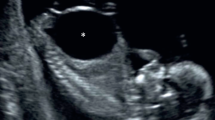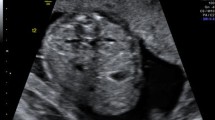Abstract
The devastation caused by fetal obstructive uropathy is now well known. At the most severe end of the spectrum of obstructive uropathy not only is the developing kidney damaged but the resultant oligohydra-mnios prevents pulmonary development and causes skeletal defects. The most significant changes are noted in patients with posterior urethral valves (PUV). The obvious solution to the problem is to either correct or by pass the obstruction prior to the development of permanent changes. Unfortunately, this simple concept is not easy to apply since it raises numerous ethical, legal, economic and technical problems.
Similar content being viewed by others
References
Molenaar JC, Carel Meijers JH, Tibboel D. The chick embryo model of fetal malformation. In: Harrison MR, Golbus MS, Filly R (eds).The Unborn Patient. Philadelphia, Saunders WB Company, 2nd edition, 1991; pp 537–547.
Harrison MR. The fetus as a patient: historical perspective. In : Harrison MR, Golbus MS, Filly R (eds).The Unborn Patient. Philadelphia, Saunders WB Company, 2nd edition, 1991; pp 3–7.
Rosenkrantz JG, Simon RC, Carlisle JH. Fetal surgery in pig with a review of other mammalian fetal technics.J Pediatr Surg 1968; 3:392–397.
Liley AW. Intrauterine transfusion of foetus in haemolytic disease.Brit M J 1963; 2:1107–1109.
Asensio SH, Figueroa-Longo JG, Pelegrina IA. Intrauterine exchange transfusion. A new technic.Obstet Gynec 1968; 32: 350–355.
Actamsons K. Fetal surgery,N Engl J Med 1966; 275:204.
Harrison MR, Filly RA, Parer JT et al. Management of the fetus with a urinary tract malformation.JAMA 1981; 246: 635–639.
Gotoh H, Masuzaki H, Fukuda Het al. Detection and assessment of pyelectasis in the fetus: relationship to postnatal renal function.Obstet Gynecol 1998; 92 : 226–231.
Harrison MR, Ross N, Noall Ret al. Correction of congenital hydronephrosis in utero I. The model: fetal urethral obstruction produces hydronephrosis and pulmonary hypoplasia in fetal lambs.J Pediatr Surg 1983; 18 : 247–256.
Cendron M, D’ Alton ME, Crombleholme TM. Prenatal diagnosis and management of the fetus with hydronephrosis.Seminars Perinatol 1994; 18:163–181.
Nakayama DK, Glick PL, Villa RLet al. Experimental pulmonary hypoplasia due to oligohydramnios and its reversal by relieving thoracic compression.J Pediatr Surg 1983; 18: 347–354.
Harrison MR, Golbus MS, Filly RA. Management of the fetus with a correctable congenital defect.JAMA 1981; 246: 774–777.
Snijders RJM, Sebire NJ, Faria Met al. Fetal mild hydronephrosis and chromosomal defects: relation to maternal age and gestation.Fetal Diagn Ther 1995; 10 : 349–355.
Fletcher JC. The fetus as patient: ethical issues. (Editorial)JAMA 1981; 246 : 772–773.
Barclay WR, McCormick RA, Sidbury JBet al. The ethics of in utero surgery.JAMA 1981; 246:1550–1555.
Kimber C, Spitz L, Cuschieri A. Current state of antenatal in utero surgical interventions.Arch Dis Child 1997; 76: F134-F139.
Radhakrishnan J, Marmer M, Holterman A, Holterman M. Antenatal diagnosis of urogenital malformations. In: Bajpai M (ed.)Progress in Pediatrics Urology. New Delhi, Inter-India Publications, 1998; Vol. II : pp 1–17.
Evans MI, Sacks AJ, Johnson MPet al. Sequential invasive assessment of fetal renal function and the intrauterine treatment of fetal obstructive uropathies.Obstet Gynecol 1991; 77: 545–550.
Campbell S, Wladimiroff JW, Dewhurst CJ. The antenatal measurement of fetal urine production.J Obstet Gynecol Br Common 1973; 80: 600.
Wladimiroff JW, Campbell S. Fetal urine production rates in normal and complicated pregnancy.Lancet 1974; 1:151.
Harrison MR, Filly RA. The fetus with obstructive uropathy: pathophysiology, natural history, selection and treatment. In : Harrison MR, Golbus MS, Filly RA (eds).The Unborn Patient. Philadelphia, WB Saunder Company, 2nd edition, 1991; pp 328–393.
Manning FA, Harrison MR, Rodeck Cet al. Catheter shunts for fetal hydronephrosis and hydrocephalus. Report of the International fetal surgery registry.N Engl Med 1986, 315: 336–340.
Estes JM, Harrison MR. Fetal obstructive uropathy.Seminars Pediatr Surg 1993; 2: 129–135.
Glick PL, Harrison MR, Golbus MSet al. Management of the fetus with congenital hydronephrosis II: Prognostic criteria and selection for treatment.J Pediatr Surg 1985; 20:276–387.
Robichaux AG III, Mandell J, Greene MFet al. Fetal abdominal wall defect: A new complication of vesicoamniotic shunting.Fetal Diagn Ther 1991; 6:11–13.
Bernaschek G, Deutinger J, Hansmann Met al. Feto-amniotic shunting — Report of the experience of four European centres.Prenat Diagn 1994; 14: 821–833.
Harrison MR, Golbus MS, Filly RAet al. Fetal surgery for congenital hydronephrosis.New Engl J Med 1982; 306:591–593.
Crombleholme TM, Harrison MR, Langer JCet al. Early experience with open fetal surgery for congenital hydronephrosis.J Pediatr Surg 1988; 23:1114–1121.
Bealer JF, Raisanen J, Skarsgard EDet al. The incidence and spectrum of neurological injury after open fetal surgery.J Pediatr Surg 1995; 30:1150–1154.
Westin B. Hysteroscopy in early pregnancy.Lancet 1954; 11:872–875.
Luks FI, Deprest JA, Vandedberghe Ket al. A model for fetal surgery through intrauterine endoscopy.J Pediatr Surg 1994; 29:1007–1009.
Crombleholme TM. Invasive fetal therapy: Current status and future directions.Semin Perinatol 1994; 18 : 385–397.
Schmidt S, Decleer W, Wagner Uet al. An approach to fetal surgery: endoscopic use of excimer laser.Eur J Obstet Gynecol Reprod Biol 1991; 42:584–586.
MacMohan RA, Renou PM, Shekleton PAet al. Severe urethral obstruction diagnosed at 14 weeks’ gestation: Variability of outcome with and without drainage.Fetal Diagn Ther 1995; 10 : 343–348.
Quintero RA, Johnson MP, Romero Ret al. In-utero percutaneous cystoscopy in the management of fetal lower obstructive uropathy.Lancet 1995; 346: 537–540.
Harrison MR, Selection for treatment: which defects are correctable. In : Harrison MR, Golbus MS, Filly RA (eds).The Unborn Patient. Philadelphia, Saunders WB Company, 1991; pp 159–165.
Author information
Authors and Affiliations
Rights and permissions
About this article
Cite this article
Radhakrishnan, J., Manickam, K., Holterman, M. et al. Antenatal urologic intervention: current status. Indian J Pediatr 66, 751–757 (1999). https://doi.org/10.1007/BF02726267
Issue Date:
DOI: https://doi.org/10.1007/BF02726267




